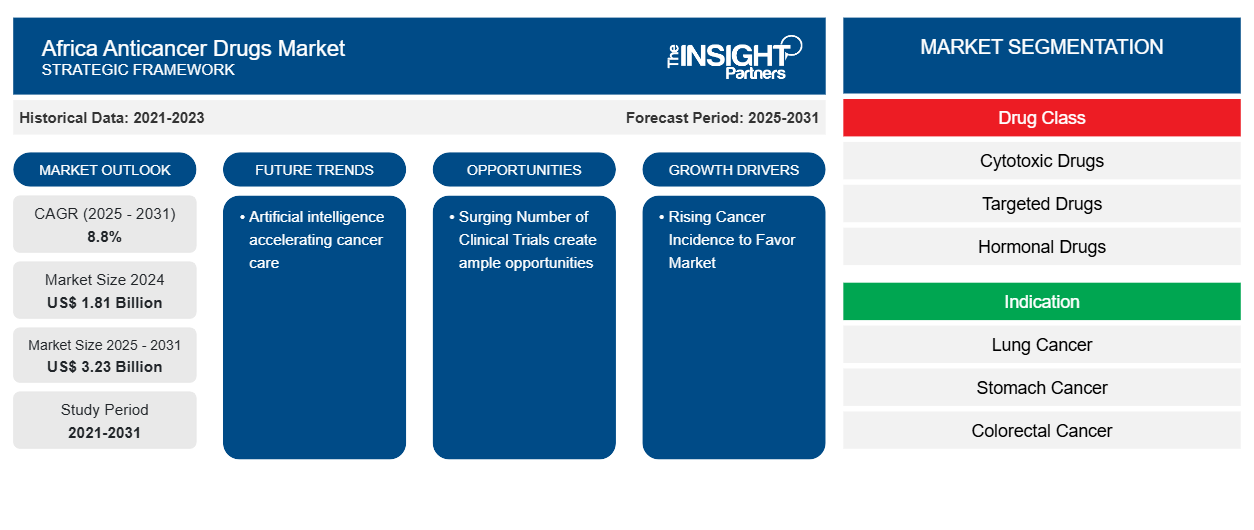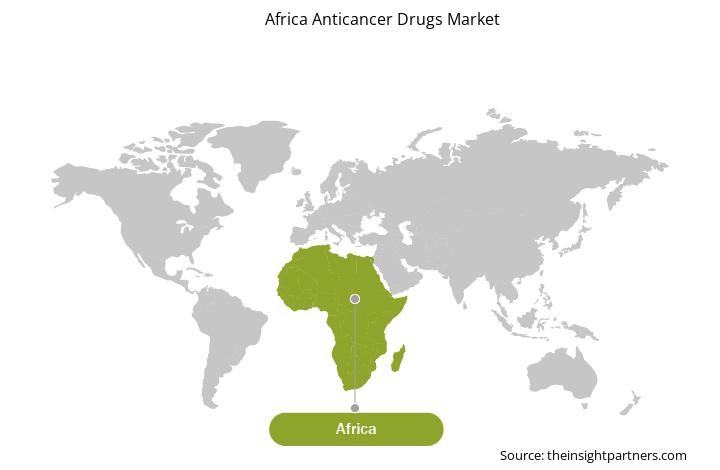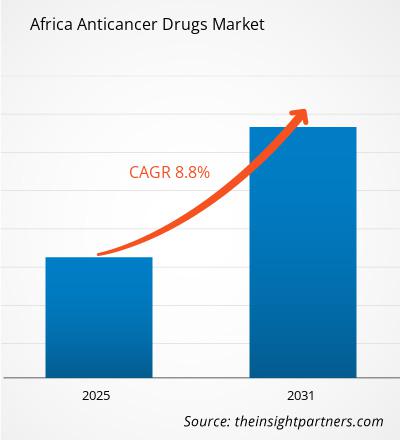非洲抗癌药物市场规模预计将从2024年的18.1亿美元增至2031年的32.3亿美元。预计2025年至2031年期间,该市场的复合年增长率将达到8.8%。人工智能加速癌症治疗很可能成为非洲抗癌药物市场的一个关键趋势。
非洲抗癌药物市场分析
癌症发病率的上升以及提高癌症认知度的举措的不断涌现是推动非洲抗癌药物市场发展的关键因素。蓬勃发展的投资和政府举措预计将在未来进一步促进市场增长。此外,临床试验数量的增加预计将在预测期内为市场增长创造充足的机会。
非洲抗癌药物市场概况
随着癌症发病率的上升以及人们对癌症治疗认识的不断提高,非洲在抗癌药物市场中的地位日益突出。制药商正在该地区投入巨资,以确保获得抗癌药物,从而提供更好的治疗选择。南非是该地区最发达的国家之一,其次是埃及。2020 年,埃及报告新增癌症病例约 150,578 例,其中最常见的疾病是乳腺癌、肝癌和膀胱癌。年龄标准化发病率为每 100,000 人口 166.1 例,表明对有效的肿瘤治疗存在需求。根据《2025 年全球经济》,2021 年人均医疗支出为 180 美元,反映了政府为改善医疗服务所做的努力。
根据《贸易经济学2025》报告,2023年埃及药品进口额为36.2亿美元。根据《全球风险共同体2025》报告,由于供应链中断和经济制约,埃及面临药品短缺,尤其是基本药物短缺。尽管面临这些挑战,但根据《阿拉伯金融2024》报告,埃及在2023年出口了价值10亿美元的药品,并计划在2024年进一步实现出口额达到15亿美元的目标。
埃及的肿瘤学格局正在发生转变,这得益于国内制药业的蓬勃发展和对创新的重新关注。然而,免疫疗法等尖端疗法的可及性仍然参差不齐,通常集中在城市中心。解决劳动力失衡问题、分散癌症诊断以及建立国际研究伙伴关系,可以成为卓有成效的战略。埃及的长期成功取决于其能否将这些努力整合成一个可扩展、可持续的癌症治疗模式。
您可以免费定制任何报告,包括本报告的部分内容、国家级分析、Excel 数据包,以及为初创企业和大学提供优惠和折扣
非洲抗癌药物市场:战略洞察

- 获取此报告的顶级关键市场趋势。此免费样品将包括数据分析,从市场趋势到估计和预测。
非洲抗癌药物市场驱动因素和机遇
癌症发病率上升利好市场
癌症已成为非洲面临的一项重大健康挑战,令人震惊的统计数据凸显了其影响。根据2024年7月发表的题为《撒哈拉以南非洲农村人口中新出现的癌症疾病负担》的文章,2020年,非洲占全球癌症负担的约5.7%(1,100,100例),死亡率约7.2%(712,800例)。据估计,到2030年,癌症将导致非洲约100万人死亡。根据GLOBOCAN 2022的数据,2022年非洲报告了118万例新发癌症病例,同年癌症相关死亡人数达到763,843人。
埃及、尼日利亚和南非等国家正经历着最高的癌症发病率和死亡率。例如,根据国际癌症研究机构 (IARC) 最新的全球癌症数据库,埃及在 2022 年估计新增癌症病例超过 150,500 例,同年癌症相关死亡人数超过 95,000 人。GLOBOCAN 2022 的估计显示,尼日利亚在 2022 年记录了 127,763 例新增癌症病例。癌症病例激增主要归因于城市化、人口老龄化和生活方式改变等风险因素。
撒哈拉以南非洲是全球宫颈癌发病率最高的地区。根据2023年3月发表的《为什么南部和东部非洲拥有全球最高的宫颈癌发病率》一文,全球超过30万女性死于宫颈癌,其中撒哈拉以南非洲近8万名女性死亡,这凸显了对有效癌症治疗的迫切需求。随着非洲癌症病例持续上升,该地区对短期和长期治疗方案的需求持续存在;因此,抗癌药物的开发和可及性对于提供针对性强、有效的治疗方案至关重要,这些方案能够满足非洲不同人群独特的医疗保健需求。因此,癌症病例的不断增加有利于非洲抗癌药物市场的增长。
临床试验数量激增
在撒哈拉以南非洲,癌症存活率(以癌症死亡率与发病率之比衡量)几乎是高收入国家的一半,这表明迫切需要开展研究来弥合这一差距。ClinicalTrials.gov(美国国立卫生研究院数据库)发表的一项临床试验综述发现,非洲仅有26项癌症相关的介入性试验,其中6项是在棕色皮肤患者为主的国家进行的。然而,这种情况似乎正在改变,并且有进展的迹象。根据2024年5月发表的一篇题为《肯尼亚临床研究中心将精准癌症治疗带到东非》的文章,瑞士制药巨头罗氏公司在非洲国家开展了61项临床试验,其中三分之二专注于肿瘤学。这些试验涵盖摩洛哥、阿尔及利亚和突尼斯等北非国家,以及加纳、肯尼亚、尼日利亚、乌干达和南非等撒哈拉以南国家。
扩大临床试验能力和投资一直是非洲癌症研究与培训组织 (AORTIC) 的关键战略目标。根据2020年7月发表的一篇题为《非洲肿瘤临床试验概况》的文章,埃及在临床试验活动方面领先于所有非洲国家,共开展45项肿瘤试验,其次是南非,开展了11项,阿尔及利亚和肯尼亚各开展了10项。北非是临床试验最密集的地区,开展了63项临床试验。这些试验主要针对乳腺癌、宫颈癌和肺癌,表明该地区针对性地开展了针对性治疗,这些癌症类型在该地区较为常见。值得注意的是,大多数试验由学术机构赞助,这凸显了研究驱动型举措在推动非洲癌症治疗方面的重要性。包括霍夫曼-罗氏在内的大型制药公司的参与也凸显了非洲大陆在全球癌症研究领域日益增长的重要性。此外,非洲药品管理局(AMA)的成立旨在协调整个非洲大陆的医疗产品法规,提高临床试验的效率,并促进新型抗癌药物的引进。
Yemaachi Biotech 的“非洲癌症图谱”和 54gene 为提升非洲基因组数据代表性所做的努力等举措,对于该地区转型为癌症研究目的地至关重要。这些项目旨在建立全面的癌症数据库,促进针对非洲人群的靶向疗法的开发。因此,非洲临床试验数量的激增为抗癌药物的进一步开发提供了重大机遇。
非洲抗癌药物市场报告细分分析
有助于得出非洲抗癌药物市场分析的关键部分是药物类别、适应症、治疗类型、剂型和部门。
- 根据药物类别,非洲抗癌药物市场细分为细胞毒性药物、靶向药物、激素药物、免疫治疗药物、基因治疗药物、放射性药物及其他。细胞毒性药物在2024年占据最大份额。靶向药物预计在2025年至2031年期间将实现最高的复合年增长率。
- 根据适应症,非洲抗癌药物市场细分为肺癌、胃癌、结直肠癌、乳腺癌、前列腺癌等。肺癌领域在2024年占据最大市场份额,而乳腺癌领域预计在2025年至2031年期间将实现最高的复合年增长率。
- 就治疗类型而言,非洲抗癌药物市场分为化疗、靶向治疗、免疫治疗、基因治疗、放射性药物治疗及其他。化疗领域在2024年占据最大市场份额,预计在2025年至2031年期间将实现最高的复合年增长率。
- 根据剂型,非洲抗癌药物市场分为片剂和胶囊剂、注射剂和液体剂。片剂和胶囊剂在2024年占据了最大的市场份额,预计在2025年至2031年期间,该细分市场将实现最高的复合年增长率。
- 按行业划分,市场分为公共部门和私营部门。2024年,公共部门占据了更大的市场份额。预计私营部门在2025年至2031年期间的复合年增长率将更高。
非洲抗癌药物市场份额(按地区)分析
非洲抗癌药物市场细分为南非、埃及、阿尔及利亚、摩洛哥、突尼斯、尼日利亚、肯尼亚、埃塞俄比亚、加纳、科特迪瓦、塞内加尔、利比亚和非洲其他地区。可负担性、可及性和卫生系统不平等问题影响着南非抗癌药物的采用。根据癌症联盟的统计,24 种基本抗癌药物中只有 7 种在公共部门提供,服务于 84% 的人口,而 21 种在私营部门提供,仅服务于 16%。据 CANSA 统计,该国 7 种最昂贵的专科药物与癌症相关,来那度胺在当地每年的费用为 882,000 兰特(48,158.5 美元),而在印度则不到 32,000 兰特(1,747.25 美元)。 Discovery Health 报告称,私营部门的五年生存率更高,凸显了医疗护理方面的不平等现象。竞争委员会指出,尽管肿瘤药物仅占整个医药市场的 1%,但却面临着过高的定价和获取壁垒。
根据 HSP News Service, LLC 2025 的报道,南非将 GDP 的约 8.5% 用于医疗保健,84% 的人口依赖公共部门,16% 的人口使用私人医疗。2020 年,南非诊断出近 110,000 例新发癌症病例,预计到 2030 年这一数字将上升到 138,000 例,到 2040 年将上升到 175,000 例。主要的癌症类型包括乳腺癌、前列腺癌、结直肠癌和宫颈癌,其中乳腺癌在女性中最为常见,前列腺癌在男性中最为常见。目前,南非的癌症治疗包括化疗、靶向治疗和免疫疗法。然而,该地区获得这些治疗的机会并不均衡。2023 年,Discovery Health Medical Scheme 为癌症治疗支付了超过 32 亿兰特(1.74 亿美元),比上一年增长了 19%。然而,只有17.1%的人口享有医疗保障,导致个人面临高昂的自付费用。根据经济复杂性观察站的数据,南非的医药贸易显示出对进口的依赖。2022年,该国进口了价值17.5亿美元的包装药品,主要来自印度、德国和法国,同时出口了价值3.22亿美元的此类商品,主要销往纳米比亚和津巴布韦等邻国。这种贸易不平衡凸显了国内市场对外国生产的肿瘤药物的依赖。
创新疗法的高昂成本限制了人们的可负担性,尤其是在公共部门。此外,复杂的监管机制可能会延迟新药的上市。地域差异加剧了药物可及性问题,由于医疗保健专业人员集中在城市中心,农村地区往往得不到充分的医疗服务。正如南非医学研究委员会和癌症联盟所指出的,改善仿制药和生物类似药的可及性、更新专利法以及加强采购系统可以降低成本并促进公平。通过公私合作战略和更强有力的卫生政策框架,南非有潜力在未来几年打造一个可持续发展的抗癌药物市场。
非洲抗癌药物市场区域洞察
Insight Partners 的分析师已详尽阐述了预测期内影响非洲抗癌药物市场的区域趋势和因素。本节还讨论了非洲抗癌药物市场在北美、欧洲、亚太地区、中东和非洲以及南美洲和中美洲的细分市场和地域分布。

- 获取非洲抗癌药物市场的区域具体数据
非洲抗癌药物市场报告范围
| 报告属性 | 细节 |
|---|---|
| 2024年的市场规模 | 18.1亿美元 |
| 2031年的市场规模 | 32.3亿美元 |
| 全球复合年增长率(2025-2031) | 8.8% |
| 史料 | 2021-2023 |
| 预测期 | 2025-2031 |
| 涵盖的领域 | 按药物类别
|
| 覆盖地区和国家 | 非洲
|
| 市场领导者和主要公司简介 |
|
非洲抗癌药物市场参与者密度:了解其对商业动态的影响
非洲抗癌药物市场正在快速增长,这得益于终端用户需求的不断增长,而这些需求的驱动因素包括消费者偏好的转变、技术进步以及对产品优势的认知度的提升。随着需求的增长,企业正在拓展产品线,不断创新以满足消费者需求,并抓住新兴趋势,从而进一步推动市场增长。
市场参与者密度是指特定市场或行业内企业或公司的分布情况。它表明特定市场空间内竞争对手(市场参与者)的数量相对于其规模或总市值而言。
在非洲抗癌药物市场运营的主要公司有:
- 安进公司
- 吉利德科学公司
- 诺华公司
- F.霍夫曼-罗氏有限公司
- 百济神州有限公司
- 武田药品工业株式会社
免责声明:以上列出的公司没有按照任何特定顺序排列。

- 了解非洲抗癌药物市场主要参与者概况
非洲抗癌药物市场新闻和最新发展
非洲抗癌药物市场的评估是通过收集一手和二手研究的定性和定量数据进行的,这些数据包括重要的企业出版物、协会数据和数据库。以下列出了市场的一些发展情况:
- 卫材株式会社通过其非洲子公司卫材制药非洲(私人)有限公司在非洲全面开展业务,通过当地分销合作伙伴销售其产品,包括抗癌药物海乐卫(Halaven)和乐伐替尼(Lenvima)以及抗癫痫药物菲康帕(Fycompa)。(来源:卫材株式会社;新闻稿;2024年)
- Kwality Pharmaceuticals Ltd. (KPL) 旗下知名肿瘤口服固体制剂 (OSD) 产品他莫昔芬 20 毫克片已通过场地转移程序在南非 (SAHPRA) 成功获得批准。(来源:Kwality Pharmaceuticals Ltd.,新闻稿,2024 年)
- 西普拉医疗公司 (Cipla Medpro) 于 2022 年 3 月与全球生物技术公司 mAbxience 签署合作协议。此举旨在为南非提供重要的肿瘤和呼吸系统相关生物仿制药。(来源:西普拉,新闻稿,2022 年)
非洲抗癌药物市场报告覆盖范围和交付成果
《非洲抗癌药物市场规模和预测(2021-2031)》报告对市场进行了详细分析,涵盖以下领域:
- 非洲抗癌药物市场规模以及区域和国家层面所有主要市场领域的预测
- 非洲抗癌药物市场趋势以及市场动态,如驱动因素、限制因素和关键机遇
- 详细的 PEST/波特五力分析和 SWOT 分析
- 非洲抗癌药物市场分析涵盖主要市场趋势、区域和国家框架、主要参与者、法规和最新市场发展
- 行业格局和竞争分析,包括市场集中度、热图分析、知名参与者以及非洲抗癌药物市场的最新发展
- 详细的公司简介
- 历史分析(2 年)、基准年、预测(7 年)及复合年增长率
- PEST和SWOT分析
- 市场规模、价值/数量 - 全球、区域、国家
- 行业和竞争格局
- Excel 数据集
近期报告
客户评价
购买理由
- 明智的决策
- 了解市场动态
- 竞争分析
- 客户洞察
- 市场预测
- 风险规避
- 战略规划
- 投资论证
- 识别新兴市场
- 优化营销策略
- 提升运营效率
- 顺应监管趋势




















 获取免费样品 - 非洲抗癌药物市场
获取免费样品 - 非洲抗癌药物市场